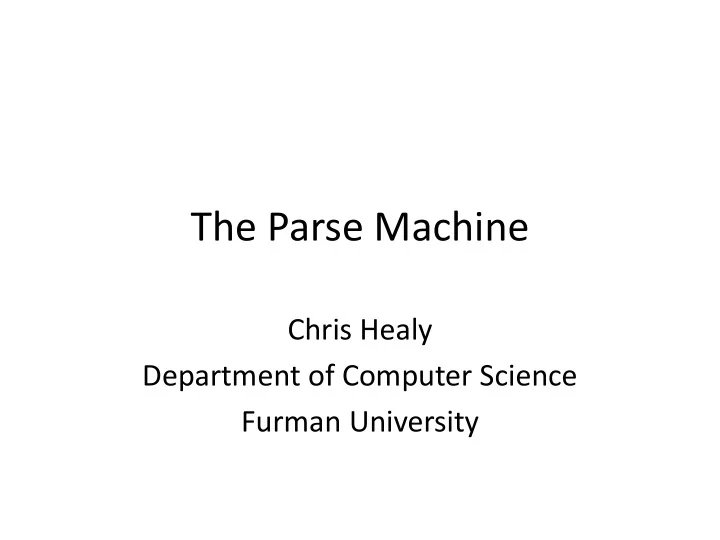

The Parse Machine Chris Healy Department of Computer Science Furman University
Rationale • All CS students use a compiler • Shouldn’t have to wait until 400/500 level course to see how a compiler works – “It’s that thing that gives me error msg about my code” • Concept of “state” already useful, e.g. by the time students reach CS 2 • My university does not have a compiler course, and only rarely offers programming languages. • Classic technique of using parse tables is less intuitive, and there is no standard notation for how to go backwards.
What is a parse machine? • Similar to Deterministic PDA, drawn like an FA • Parse stack: maintain a history of visited states • States: determined from all possible positions the cursor could be in while reading input w.r.t. grammar – Special states called “Reduce Blocks” tell you to go backwards. • Transitions: Go to the next state based on current terminal or nonterminal in the input. – Crash/reject if unspecified “syntax error” – When you “reduce”, you insert a nonterminal into the input.
“Reduce” • One important concept is reducing a nonterminal. • Once we have read some input, we may have just finished an important part of the input. – This happens when the cursor is at the end of the RHS of a production. • Example: S AB A aaa B bb • When we read the string “aaabb”… – We arrive at aaa • bb. We can reduce the “aaa” to A to obtain A • bb. – When we arrive at Abb • , we can reduce the “bb” to B to obtain AB • . – Knowing that we just read AB, we can reduce it to S • .
Example • First example machine that I show my class uses this grammar. S 0A0 A 1 | 1A • There are a total of 6 states – The start state is S • 0A0 – One state is the accept state
Creating states Creating states for the example parse machine . State Items Go to state On input(s) S • 0 A 0 0 1 0 S 0 • A 0 1 2 A A • 1 3 1 A • 1 A 3 1 S 0 A • 0 2 4 0 A 1 • 3 Reduce $, 0 A 1 • A 5 A A • 1 3 1 A • 1 A 3 1 S 0 A 0 • 4 Accept $ A 1 A • 5 Reduce $, 0
Example with Input • Suppose we want to parse 0110 with the grammar S 0A0 and A 1 | 1A. • The steps in the trace are as follows. State Stack Input String Next State • 0 1 1 0 0 1 0 • 1 1 0 0 1 3 0 1 • 1 0 0 1 3 3 0 1 1 1 • 0 0 1 3 3 Need to backtrack: –1, A 0 1 1 • A 0 0 1 3 5 0 1 1 A • 0 0 1 3 5 Need to backtrack: –2, A 0 1 1 A • A 0 0 1 2 0 1 1 A A • 0 0 1 2 4 (accept state)
Fitting into a course • Unit on bottom-up parsing takes 1 week • Currently in our Computational Theory course • Pre-requiste ideas – Helpful to know basic phases of compilation: scanning, parsing, code generation – Simple CFGs: can motivate with how we define mathematical expressions to enforce precedence & associativity – If desired: CYK algorithm to see if input string can be generated by grammar. Dynamic programming O(n 3 ). Motivates need for efficient algorithm.
Outline of lessons • Assumes 50-minute period • Day 1 – Running a parse machine. (~20 minutes) – Goto and reduce actions. The parse stack. – Introduction to creating parse machine: how to create the individual states. “Sets of items” • Day 2 – How to specify “reduce” actions. – Calculate the First and Follow of a nonterminal. • Day 3: Extended example, which handles the special case where a nonterminal can generate ε .
Conclusion • Can discuss with student what happens with real compiler – Hundreds of states… – Distinction between syntax and semantic errors • After the unit, can talk about parse table as a convenient representation for implementation – Realization that many transitions are not specified! • Goal is to gain a deeper appreciation of a programming language as defined by CFG • Do it early in the curriculum, if you can spare a week in discrete math or CS 2.
Recommend
More recommend